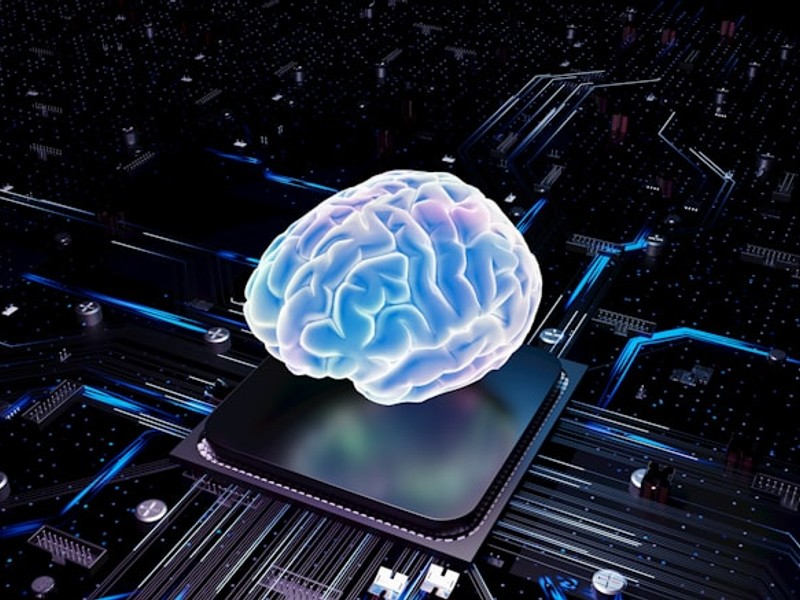AI Tools 2025 Trends: Powering the Future of Innovation
Artificial intelligence is rapidly evolving, and understanding the AI tools 2025 trends is crucial for businesses and individuals alike. This article dives deep into the key advancements shaping the AI landscape, providing actionable insights to help you navigate this transformative technology. We'll explore practical applications, emerging trends, and what you need to know to stay ahead of the curve. From no-code AI platforms to advanced generative AI models, the future is being built with AI, and this guide will equip you with the knowledge to participate.
1. The Rise of No-Code AI Platforms

AI Tools 2025 Trends: Powering the Future of Innovation - Image 1
No-code AI platforms are democratizing access to artificial intelligence, making it easier for individuals with limited programming experience to leverage its power. These platforms provide intuitive interfaces and pre-built components, allowing users to build and deploy AI models without writing a single line of code. This trend is expected to accelerate in 2025, empowering citizen developers and accelerating AI adoption across various industries.
Democratizing AI Development
No-code AI platforms are breaking down the barriers to AI development, enabling a wider range of individuals and organizations to participate. This democratization is fostering innovation and driving the development of new AI-powered applications.
Key Features of No-Code AI Platforms
- Drag-and-drop interfaces: Simplifies model creation and deployment.
- Pre-built AI components: Offers ready-to-use modules for common AI tasks.
- Automated machine learning (AutoML): Automates the process of model selection and optimization.
- Visual data pipelines: Streamlines data preparation and integration.
Practical Applications
- Customer service automation: Building chatbots and virtual assistants without coding.
- Predictive analytics: Forecasting sales, identifying customer churn, and optimizing marketing campaigns.
- Image recognition: Automating image classification and object detection tasks.
- Process automation: Streamlining business processes and reducing manual tasks.
2. Generative AI: Beyond Text and Images
Generative AI, which includes models like DALL-E 3, Midjourney, and Stable Diffusion, has already revolutionized content creation. In 2025, we'll see generative AI expand beyond text and images, with applications in areas such as:
Generative AI for Code Generation
AI models capable of generating code are becoming increasingly sophisticated. These models can assist developers in writing code, debugging errors, and automating repetitive tasks. This trend will significantly increase developer productivity and accelerate software development.
Generative AI for 3D Modeling
Generative AI is transforming 3D modeling, enabling users to create complex 3D models from simple text prompts or sketches. This technology is revolutionizing industries such as gaming, animation, and product design.
Generative AI for Drug Discovery
AI is accelerating drug discovery by generating novel molecular structures and predicting their properties. This technology has the potential to significantly reduce the time and cost associated with developing new drugs.
Generative AI for Music Composition
AI models are now capable of composing original music in various styles. This technology is empowering musicians and creating new opportunities for music creation and production.
3. AI-Powered Cybersecurity
The increasing sophistication of cyber threats is driving the adoption of AI-powered cybersecurity solutions. These solutions can detect and respond to threats in real-time, providing a more proactive and effective defense against cyberattacks.
Threat Detection and Prevention
AI algorithms can analyze network traffic and system logs to identify anomalies and potential security threats. These algorithms can also predict future attacks and proactively implement preventative measures.
Automated Incident Response
AI can automate the incident response process, quickly identifying and containing security breaches. This reduces the time and resources required to respond to cyberattacks.
Vulnerability Management
AI can scan systems for vulnerabilities and prioritize remediation efforts. This helps organizations to proactively address security weaknesses and reduce their risk of being compromised.
4. Edge AI: Processing Data Closer to the Source
Edge AI involves processing data closer to the source, such as on mobile devices, sensors, and IoT devices. This reduces latency, improves privacy, and enables real-time decision-making. The trend will continue to grow in 2025 as more organizations seek to leverage the benefits of edge computing.
Benefits of Edge AI
- Reduced latency: Faster response times for real-time applications.
- Improved privacy: Data is processed locally, reducing the risk of data breaches.
- Increased bandwidth efficiency: Reduces the amount of data that needs to be transmitted over the network.
- Enhanced reliability: Edge devices can continue to operate even when disconnected from the network.
Practical Applications
- Autonomous vehicles: Processing sensor data in real-time to make driving decisions.
- Smart manufacturing: Monitoring equipment performance and predicting maintenance needs.
- Healthcare: Analyzing patient data at the point of care to provide personalized treatment.
- Retail: Optimizing inventory management and personalizing customer experiences.
5. Explainable AI (XAI): Building Trust and Transparency
As AI becomes more prevalent, it's crucial to understand how AI models make decisions. Explainable AI (XAI) aims to make AI models more transparent and understandable, building trust and ensuring accountability. XAI is becoming increasingly important for regulatory compliance and ethical considerations.
Importance of XAI
- Building trust: Users are more likely to trust AI systems they understand.
- Ensuring accountability: XAI helps to identify and address biases in AI models.
- Improving decision-making: Understanding how AI models arrive at their conclusions can help humans make better decisions.
- Regulatory compliance: Many regulations require AI systems to be transparent and explainable.
Techniques for XAI
- Feature importance: Identifying the features that have the most influence on the model's predictions.
- SHAP values: Quantifying the contribution of each feature to the prediction.
- LIME: Approximating the model's behavior locally to understand why it made a particular prediction.
- Decision trees: Visualizing the decision-making process of the AI model.
6. AI and the Metaverse: Immersive Experiences
AI is playing a crucial role in the development of the metaverse, enabling more immersive and interactive experiences. AI-powered avatars, virtual assistants, and content creation tools are enhancing the metaverse and making it more engaging.
AI-Powered Avatars
AI can create realistic and expressive avatars that can mimic human emotions and behaviors. These avatars can interact with users in a natural and intuitive way, enhancing the sense of presence in the metaverse.
Virtual Assistants
AI-powered virtual assistants can provide personalized support and guidance within the metaverse. These assistants can answer questions, provide recommendations, and help users navigate the virtual world.
Content Creation Tools
AI can generate 3D models, textures, and other content for the metaverse. This simplifies the content creation process and makes it easier for users to create their own virtual worlds.
7. Quantum AI: A Paradigm Shift
While still in its early stages, quantum AI has the potential to revolutionize the field of artificial intelligence. Quantum computers can perform calculations that are impossible for classical computers, opening up new possibilities for AI research and development. Though widespread application is further out, 2025 will see increased research and development in this area.
Potential Applications of Quantum AI
- Drug discovery: Simulating molecular interactions to accelerate the development of new drugs.
- Materials science: Designing new materials with specific properties.
- Financial modeling: Optimizing investment strategies and managing risk.
- Cryptography: Breaking existing encryption algorithms and developing new quantum-resistant algorithms.
8. Sustainable AI: Addressing Environmental Concerns
The environmental impact of AI is becoming an increasingly important concern. Training large AI models can consume significant amounts of energy, contributing to carbon emissions. Sustainable AI aims to develop AI technologies that are more energy-efficient and environmentally friendly.
Strategies for Sustainable AI
- Model optimization: Reducing the size and complexity of AI models to reduce their energy consumption.
- Hardware acceleration: Using specialized hardware to accelerate AI computations and reduce energy consumption.
- Renewable energy: Powering AI infrastructure with renewable energy sources.
- Data center optimization: Improving the energy efficiency of data centers.
Conclusion
The AI tools 2025 trends are poised to reshape industries and redefine how we interact with technology. From the democratization of AI through no-code platforms to the transformative potential of generative AI and the crucial role of explainable AI, understanding these trends is essential for staying competitive. Embrace these advancements, explore their practical applications, and prepare for a future powered by intelligent machines. Keep exploring, keep learning, and get ready to leverage the power of AI tools to create a brighter, more innovative future.
FAQ
Q: What are the key AI tools 2025 trends to watch out for?
A: The key trends include the rise of no-code AI platforms, the expansion of generative AI beyond text and images, AI-powered cybersecurity, edge AI, explainable AI (XAI), AI and the metaverse, quantum AI, and sustainable AI.
Q: How can no-code AI platforms benefit my business?
A: No-code AI platforms democratize AI development, making it easier for individuals with limited programming experience to build and deploy AI models. This can accelerate innovation, reduce costs, and improve efficiency.
Q: What is explainable AI (XAI) and why is it important?
A: Explainable AI (XAI) aims to make AI models more transparent and understandable. It's important for building trust, ensuring accountability, improving decision-making, and complying with regulations.
Q: What is the potential of generative AI beyond text and images?
A: Generative AI is expanding into areas such as code generation, 3D modeling, drug discovery, and music composition, revolutionizing these industries.
Q: How can I prepare for the future of AI?
A: Stay informed about the latest AI trends, explore practical applications of AI in your industry, invest in AI training and education, and consider adopting AI-powered tools and solutions.



